


Notice: This is the official website of the All Empires History Community (Reg. 10 Feb 2002)
~ 1,000 Pics About Mongols ~ |
Post Reply 
|
Page 123 5> |
| Author | |
lionmaster 
Knight 
Joined: 08-Jul-2010 Location: UK Online Status: Offline Posts: 95 |
 Quote Quote  Reply Reply
 Topic: ~ 1,000 Pics About Mongols ~ Topic: ~ 1,000 Pics About Mongols ~Posted: 22-Dec-2013 at 19:07 |
The Hun and Mongol connectionA new thesis paper by Kim K. et al. A western Eurasian male is found in 2000-year-old elite Hun cemetery in Northeast Mongolia. Am J Phys Anthropol. 2010 Jul;142(3):429-40. doi: 10.1002/ajpa.21242., is helping to clarify the relationship between the Hun, and prehistoric and modern Mongols, and to other ethnic groups, such as the Turks, Europeans, Chinese, Liaoning and Japanese populations. Several indicators suggest the cemetery of Borkhan Tolgoi represented only a subset of the Hun community, who appear to have been high-status individuals. These include low-burial frequency, funerary artifacts, elaborate practices, including the use of coffins and chests, and the depth of the graves (two to five meters). The genetic analysis performed by Keyser-Tracqui et al. (2003a, 2003b) found that the majority of the Hun mtDNA sequences belong to predominately Asian haplogroups, however a few(11%) belong to predominately Europeans haplogroups. The DNA analyses [on three skeletons found in a 2,000-year-old Hun elite cemetery in Duurlig Nars of Northeast Mongolia] revealed that one subject was an ancient male skeleton with maternal U2e1 and paternal R1a1 haplogroups. This is the first genetic evidence that a male of distinctive Indo-European lineages (R1a1) was present in the Hun of Mongolia. This might indicate an Indo-European migration into Northeast Asia 2,000 years ago. Other specimens are a female with mtDNA haplogroup D4 and a male with Y-SNP haplogroup C3 and mtDNA haplogroup D4. Those haplogroups are common in Northeast Asia (D4 is frequently detected across Japan). Egiin Gol cemetery features 219 skeletal material from 99 individuals buried from the third century B.C. to the second century A.D. The necropolis was arranged into three main sections that roughly correspond to temporal ordering as measured through AMS carbon-14 dating (Fig. 8.1). Section A is the oldest followed by Section B and Section C. Section A contains a number of “double burials” near graves marked with higher status individuals. This practice was quite common among peoples of the Scytho-Siberian tradition, including the Sakka (Yakuts)and the Bronze Age Pazyryk culture of the Gorny Altai in southern Siberia (Chikisheva,2000; Ricaut et al., 2004a, 2004b; Amory et al., 2006). This practice has been reported in Murail et al. (2000) who investigated part of the Egiin Gol cemetery. Section C of the necropolis is interesting as it corresponds to the end of the cemetery’s use and may be associated with a Turkish influence of the Hun tribe(Keyser-Tracqui et al., 2003a). Based on STR (short-tandem repeat) genetic markers(autosomal and Y chromosome) and mtDNA, Keyser-Tracqui et al. (2003a) found distinct signatures unique to this section of the necropolis. Specifically, they found markers of a Turkish origin and a characteristically kin grouping in Section C that would seem to indicate a demographic shift in the necropolis toward the end of the Hun Empire. Clearly from the cluster analysis, the Egiin Gol individuals show an affinity with the small sample of Mongol Turk from the 8th century A.D.Ricaut et al. (2010) also detected this unique signature in Section C using nonmetric cranial traits. Bennett and Kaestle (2006) also investigated the cemetery using mtDNA and included a greater diversity of populations that may be representative of the individuals buried at Borkhan Tolgoi. Using pairwise genetic distance (FST) derived from mtDNA HVSI sequences to calculate between pairs of populations, these authors found the individuals buried in the Egiin Gol cemetery showed close affinity with other East Asians, including Mongolian, Japanese, and Chinese, . This finding is similar to what Keyser-Tracqui et al. (2003) found using haplogroup data (89%of sequenced individuals belonged to Asian specific haplogroups) The analysis of 3D geometric morphometrictraits used in this dissertation also indicates a distinction among the Egiin Gol sample from the pooled Hun sample. The paper, establishes the following strong or close connections and genetic affinities: between the Hun and Bronze Age Mongols as well as modern Mongols ( This finding shows a clear line of descent from the Hun polity through to those people now inhabiting the modern nation-state of Mongolia); between the Hun (section C and at the end phase of the Egiin Gol necropolis) and Turks (of the 8th century) and the Pazyrk-Altai ancient Scythian remains ( ”Of importance to this dissertation, however, is the fact that, archaeologically, there is a material and cultural (and perhaps genetic) connection from Bronze Age Mongolia through the Uighur/Turk period, at least for the Egiin Gol valley, and perhaps throughout Mongolia during that period as well.”); between the Hun (Egiin Gol sample) and the Chandman, and who cluster strongest with Japanese, as well as Czech samples. [Note: The Chandman hail from mountainous basin and range country in eastern Khovd Aimag, western Mongolia, about 1,050 km west of the capital Ulaanbaatar. And higher dimension PCs did exhibit a relationship of the Chandman and Pazyryk people(who are closely related to the Siberian Tagar people)] and using FST values, the Hun-Mongol samples are similar to the Czech, and Jomon; between the Hun and the Sakka-related Yakuts, a pastoral people who inhabit areas of the Sakha Republic in eastern Siberia. It is widely believed that the Yakuts were the first settlers of the Altai-Baikal region of east Siberia (Amory et al.,2006) . The results for the autosomal and Y-STR loci indicate a close biological relationship among the ancient Egiin Gol sample and modern Mongolian samples; between the Hun and modern Mongols … with Liaoning (0.108), the Eastern Han (0.128), and the Qinghai (0.129). (Other studies have shown the Japanese genetic affinity with all three groups as well), and therefore between the Hun and East Asians including the Japanese (Using pairwise genetic distance (FST) derived from mtDNA HVSI sequences to calculate between pairs of populations, these authors found the individuals buried in the Egiin Gol cemetery showed close affinity with other East Asians, including Mongolian, Japanese, Chinese Han, and Northeastern Chinese). Between Hun and Xinjiang samples based on FST values. Therefore, although there may have been a component of the Hun that were not entirely Mongol, there is a strong connection for at least some segment of the Hun society. Note: The Liaoning sample dates from the second to third century AD. According to archaeological and historical evidence, the individuals buried at this cemetery might the descendants of the Donghu people, who, according to Chinese accounts, were a Mongolic nomadic people who occupied northeastern China. These people were later broken into the Xianbei Empire, who have historic ties to the Hun and modern Mongolian peoples (Di Cosmo, 2002). There is also a close relationship with samples from Qinghai, which span several periods, ranging from the Han through the Jin (265 – 420 CE). This area has also historically been a melting pot of peoples, having been home to the Xianbei, Turkic, and Mongols. In the PC plots, the Hun also group together with samples from the Eastern Han Empire (25 – 220 CE). This sample (Eastern Han) comes from several locations in Inner Mongolia … The affinity between the Hun sample and the Qinghai, Liaoning, and the Eastern Han is also seen in the distance matrices (Mahalanobis and R-matrix). After the Mongol Period and modern Mongolian sample, the next closest D2 distances are the Though not shown,the R-matrix shows this observation as well, as all three of these samples are positive, indicating some level of gene flow among these groups. ::: The Naadam Festival of Mongolia which centers around the three “men’s sports” of horse racing, wrestling and archery, practiced for centuries as intrinsic parts of nomadic life, is similar to the oft seen Japanese equivalents of horse racing, sumo-wrestling and archery displays during shrine festivals events, such as the annual yabusame archery event held at Kamakura‘s Tsurugaoka Hachiman-gu Temple.  Edited by lionmaster - 23-Dec-2013 at 18:03 |
|
 |
|
lionmaster 
Knight 
Joined: 08-Jul-2010 Location: UK Online Status: Offline Posts: 95 |
 Quote Quote  Reply Reply
 Posted: 18-Dec-2013 at 19:10 Posted: 18-Dec-2013 at 19:10 |

|
|
 |
|
lionmaster 
Knight 
Joined: 08-Jul-2010 Location: UK Online Status: Offline Posts: 95 |
 Quote Quote  Reply Reply
 Posted: 18-Dec-2013 at 18:59 Posted: 18-Dec-2013 at 18:59 |

|
|
 |
|
lionmaster 
Knight 
Joined: 08-Jul-2010 Location: UK Online Status: Offline Posts: 95 |
 Quote Quote  Reply Reply
 Posted: 18-Dec-2013 at 18:54 Posted: 18-Dec-2013 at 18:54 |
|
Khulegu Khan’s Mission  Edited by lionmaster - 18-Dec-2013 at 18:56 |
|
 |
|
lionmaster 
Knight 
Joined: 08-Jul-2010 Location: UK Online Status: Offline Posts: 95 |
 Quote Quote  Reply Reply
 Posted: 17-Dec-2013 at 06:36 Posted: 17-Dec-2013 at 06:36 |
|
The Battle of Ankara (1402) decimated Ottoman power in Anatolia. Bayazid I, who might very well have been remembered in history as the Napoleon of the era, was captured by Tamerlane and died in captivity. The eruption of Tamerlane had taken place just as Constantinople was negotiating a surrender of the city to Bayazid. The Battle of Ankara postponed the conquest of the Byzantine capital by more than fifty years. Sultan Bayezid of Ottoman Empire prisoned by the Mongol conqueror Tamerlane, 1878, depicting the capture of Bayezid by Tamerlane.  Edited by lionmaster - 17-Dec-2013 at 06:40 |
|
 |
|
lionmaster 
Knight 
Joined: 08-Jul-2010 Location: UK Online Status: Offline Posts: 95 |
 Quote Quote  Reply Reply
 Posted: 17-Dec-2013 at 06:34 Posted: 17-Dec-2013 at 06:34 |
|
Tamerlane and his forces advance against the Golden Horde, Khan Tokhtamysh.  |
|
 |
|
lionmaster 
Knight 
Joined: 08-Jul-2010 Location: UK Online Status: Offline Posts: 95 |
 Quote Quote  Reply Reply
 Posted: 17-Dec-2013 at 06:31 Posted: 17-Dec-2013 at 06:31 |
|
Tamerlane defeating the Mamluk of Egypt, 1399.  |
|
 |
|
lionmaster 
Knight 
Joined: 08-Jul-2010 Location: UK Online Status: Offline Posts: 95 |
 Quote Quote  Reply Reply
 Posted: 17-Dec-2013 at 06:29 Posted: 17-Dec-2013 at 06:29 |
|
The siege of Zhongdu (modern Beijing) in 1213-14  Edited by lionmaster - 17-Dec-2013 at 06:37 |
|
 |
|
lionmaster 
Knight 
Joined: 08-Jul-2010 Location: UK Online Status: Offline Posts: 95 |
 Quote Quote  Reply Reply
 Posted: 17-Dec-2013 at 06:14 Posted: 17-Dec-2013 at 06:14 |

|
|
 |
|
lionmaster 
Knight 
Joined: 08-Jul-2010 Location: UK Online Status: Offline Posts: 95 |
 Quote Quote  Reply Reply
 Posted: 17-Dec-2013 at 06:06 Posted: 17-Dec-2013 at 06:06 |

|
|
 |
|
lionmaster 
Knight 
Joined: 08-Jul-2010 Location: UK Online Status: Offline Posts: 95 |
 Quote Quote  Reply Reply
 Posted: 17-Dec-2013 at 05:58 Posted: 17-Dec-2013 at 05:58 |

|
|
 |
|
lionmaster 
Knight 
Joined: 08-Jul-2010 Location: UK Online Status: Offline Posts: 95 |
 Quote Quote  Reply Reply
 Posted: 17-Dec-2013 at 05:53 Posted: 17-Dec-2013 at 05:53 |
 
Edited by lionmaster - 17-Dec-2013 at 06:05 |
|
 |
|
lionmaster 
Knight 
Joined: 08-Jul-2010 Location: UK Online Status: Offline Posts: 95 |
 Quote Quote  Reply Reply
 Posted: 17-Dec-2013 at 05:49 Posted: 17-Dec-2013 at 05:49 |
  Edited by lionmaster - 17-Dec-2013 at 06:09 |
|
 |
|
lionmaster 
Knight 
Joined: 08-Jul-2010 Location: UK Online Status: Offline Posts: 95 |
 Quote Quote  Reply Reply
 Posted: 17-Dec-2013 at 05:41 Posted: 17-Dec-2013 at 05:41 |
     |
|
 |
|
lionmaster 
Knight 
Joined: 08-Jul-2010 Location: UK Online Status: Offline Posts: 95 |
 Quote Quote  Reply Reply
 Posted: 17-Dec-2013 at 05:33 Posted: 17-Dec-2013 at 05:33 |
|
Golden Horde belt currently at the Hermitage Museum. The Hermitage Museum's website has this belt dated at 13th - early 14th century. The "Treasures of the Golden Horde" exhibition review at Cloudband.com has it as mid-13th century (1227 to mid 1270ies). The belt is described at the Russian version of the relevant Hermitage page as Gold, consisting of seventeen objects. According to the same reference, the belt belonged to a representative of the house of Batu-Khan.   |
|
 |
|
lionmaster 
Knight 
Joined: 08-Jul-2010 Location: UK Online Status: Offline Posts: 95 |
 Quote Quote  Reply Reply
 Posted: 17-Dec-2013 at 05:31 Posted: 17-Dec-2013 at 05:31 |
|
Arch decoration for a saddle, Mongolian, 13th - 14th century. This arch decoration made of gold leaf is part of a set of six gold facings used to decorate a wooden saddle discovered in the tomb of a young Mongol noblewoman. 1 Like all Central and East Asian nomadic peoples, the Mongols were passionate about their horses; furthermore, they to accorded a higher status and more physical freedom to women than the Chinese. For these reasons, it is not surprising for equestrian equipment to be found in the tomb of a Mongol female, although a saddle decorated with gold such as this is certainly a rare object. The saddle ornaments found in the tomb were crafted by hammering the gold leaf over a relief-carved mold. The decorative motif is that of a reclined deer framed in a four-petal blossom lozenge and surrounded by vines, leaves and flowers. Adam T. Kessler, Empires Beyond the Great Wall: The Heritage of Genghis Khan (Los Angeles: Natural History Museum of Los Angeles County 1993), p. 160.  |
|
 |
|
lionmaster 
Knight 
Joined: 08-Jul-2010 Location: UK Online Status: Offline Posts: 95 |
 Quote Quote  Reply Reply
 Posted: 17-Dec-2013 at 05:30 Posted: 17-Dec-2013 at 05:30 |
|
Ornamental plaque with abstract animal design, 3rd to 4th century CE.An inscription is located on the back side of this early Tuoba Sumbe piece, a three-letter line that reads: "Yituo's gold."It is generally believed that the Hunnu were for the most part absorbed by the Sumbe after the break-up of their empire. One scholar has noted that the workmanship of this plaque appears to be Hunnu, but the motif is distinctly Sumbe, 1 an observation shich may suggest that many aspects of Hunnu culture remained distinct many centuries after the dissolution of their empire.Adam T. Kessler, Empires Beyond the Great Wall: The Heritage of Genghis Khan (Los Angeles: Natural History Museum of Los Angeles County, 1993), p. 79.  |
|
 |
|
lionmaster 
Knight 
Joined: 08-Jul-2010 Location: UK Online Status: Offline Posts: 95 |
 Quote Quote  Reply Reply
 Posted: 17-Dec-2013 at 05:28 Posted: 17-Dec-2013 at 05:28 |
|
Eagle-shaped gold crown. This collection was produced during the Warring States period and unearthed from the Hunnu grave in Hangjinqi, Shouthern Mongolia. At the top of the Crown is an eagle spreading its wings, and in the middle is a painting of four wolves, four sheep, a tiger, sheep and horsey. The technological level of this gold crown is high. It represents the highest level of precious metal manufacturing technology of Hunnu in the Warring States period.  |
|
 |
|
lionmaster 
Knight 
Joined: 08-Jul-2010 Location: UK Online Status: Offline Posts: 95 |
 Quote Quote  Reply Reply
 Posted: 17-Dec-2013 at 05:27 Posted: 17-Dec-2013 at 05:27 |
|
Gold Belt Buckle, Mongol, 3rd-2ndC BCE,from Siberia, 3 1/8” high. Animal-Style: Eurasian Steppes throughout the 1st Millenium. 
|
|
 |
|
Snafu 
Knight 
Joined: 14-Aug-2004 Online Status: Offline Posts: 72 |
 Quote Quote  Reply Reply
 Posted: 17-Dec-2013 at 05:24 Posted: 17-Dec-2013 at 05:24 |
|
Khitans, from 12th century painting
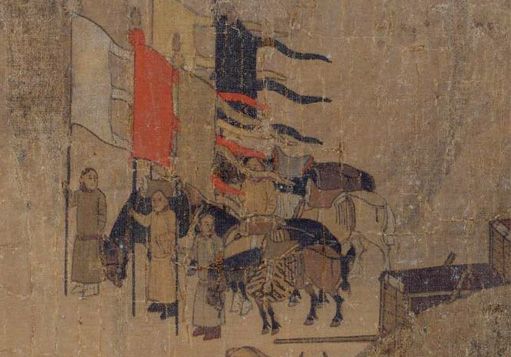 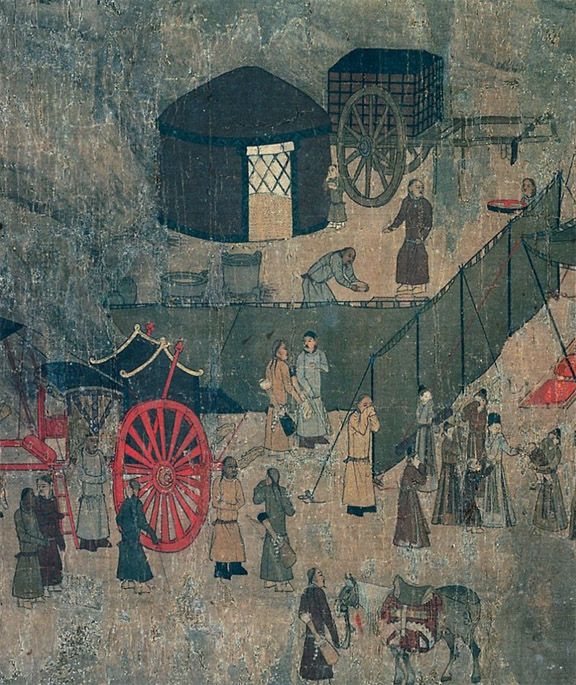 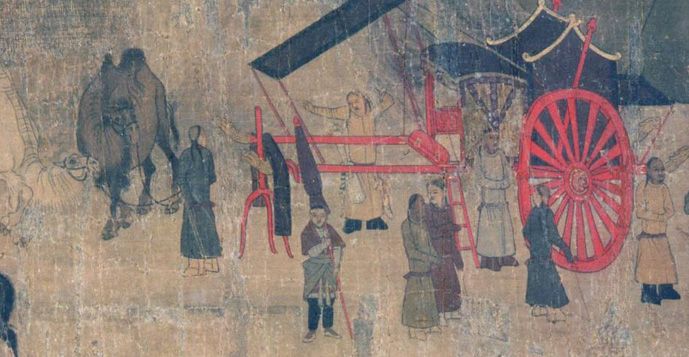 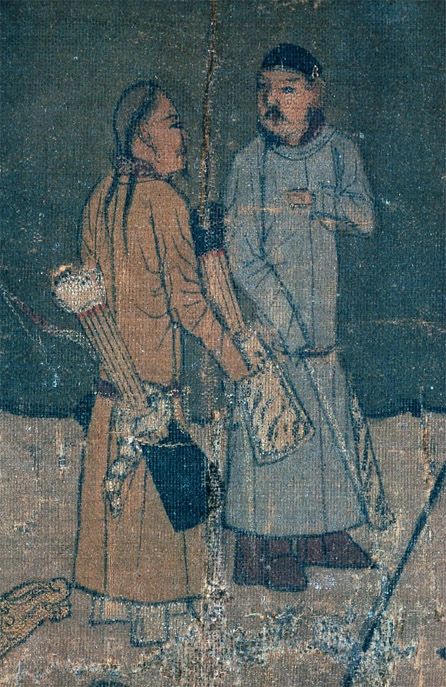 Nomad ladies leading camel 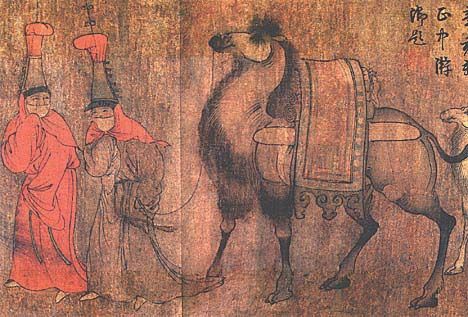 Nomads from a 13th century painting  |
|
 |
|
Post Reply 
|
Page 123 5> |
| Forum Jump | Forum Permissions  You cannot post new topics in this forum You cannot reply to topics in this forum You cannot delete your posts in this forum You cannot edit your posts in this forum You cannot create polls in this forum You cannot vote in polls in this forum |
Bulletin Board Software by Web Wiz Forums® version 9.56a [Free Express Edition]
Copyright ©2001-2009 Web Wiz
This page was generated in 0.063 seconds.
Copyright ©2001-2009 Web Wiz
This page was generated in 0.063 seconds.












 Printable Version
Printable Version Google
Google Delicious
Delicious Digg
Digg StumbleUpon
StumbleUpon Windows Live
Windows Live Yahoo Bookmarks
Yahoo Bookmarks reddit
reddit Facebook
Facebook MySpace
MySpace Newsvine
Newsvine Furl
Furl Topic Options
Topic Options